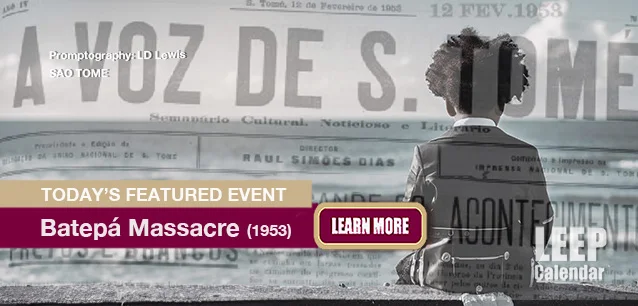 AD
AD
Today is: December 31
Scroll to explore events active on this date.
Additional Events on LEEP
LEEP INK FEATURES

August? Absolutely!
In August, we live through the Dog Days of Summer. It's hot and often humid, and those who can leave for better climates do. Down south, winter is in full force. August is also known as "the ...

In The Heat of July: July 2025 Events
Is it hot enough (or cold enough if you're below the equator) for you yet? There is actually a day for that! Like every month, I pick a diverse collection of events you may or may not know about. This ...

May Blooms: Events in May 2025
Along with October, May is one of the most densely packed months of the year. It's before the summer humidity and the last whole month of the school year. The weather is warming in t...
About São Tomé's Batepá Massacre
Politics , Africa
Ends: Feb 03, 2024
DESCRIPTION:
The Batepá Massacre, a somber and significant event in the history of São Tomé and Príncipe, unfolded on February 3, 1953. This tragic incident is remembered for its brutal repression by the colonial Portuguese authorities against native Creoles, known as "Forros."
Tension had been escalating in the archipelago, primarily due to the oppressive labor practices enforced by the Portuguese. São Tomé and Príncipe, a Portuguese colony since the late 15th century, had become a significant cocoa producer by the early 20th century, relying heavily on forced labor. The Forros, descendants of freed slaves and the native population, vehemently resisted these exploitative practices.
In the early 1950s, under António de Oliveira Salazar, the Portuguese regime sought to intensify labor exploitation to boost cocoa production. They implemented labor reforms that further eroded the rights of the native workers. The Forros perceived these reforms as a direct threat to their freedom and livelihoods, which heightened tensions between the colonists and the natives.
On February 3, 1953, these tensions reached a boiling point. The Portuguese authorities, citing a planned uprising by the Forros, carried out a violent crackdown. Official accounts of the death toll vary. The number most commonly quoted is that hundreds of natives were killed, with some estimates suggesting that up to 1,000 Forros lost their lives. The massacre was followed by a period of intense repression, with many Forros fleeing to the jungle to escape further violence.
The Batepá Massacre remains a pivotal moment in the history of São Tomé and Príncipe. It symbolizes the brutal legacy of colonialism and the extreme measures colonial powers employed to suppress resistance. The massacre played a significant role in galvanizing anti-colonial sentiment, contributing to the eventual independence movement in São Tomé and Príncipe, culminating in independence from Portugal in 1975.
Remembering the Batepá Massacre is crucial for acknowledging and understanding the impacts of colonial rule in São Tomé and Príncipe. It serves as a reminder of the atrocities committed under colonialism and the enduring struggle for freedom and human rights in post-colonial states. The memory of the massacre continues to influence the nation's cultural and political landscape, underscoring the importance of historical reflection and the pursuit of justice and reconciliation.
VIDEOS
SUPPORTING DOCUMENTS
Currently, this event does not have supporting documents.
ADDITIONAL IMAGES
Currently, this event does not have supporting images.
Where would you like to go now?
 AD
AD


/footer-logo.svg)
